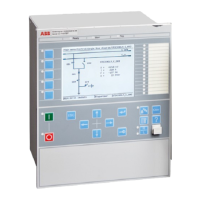signal in this case is thus that resetting of TR1ATCC or TR8ATCC can sometimes be made
faster, which in turn makes the system ready for consecutive commands in a shorter time.
The second use is to detect a jammed tap changer. If the timer
tTCTimeout
times out before
the TCINPROG signal is set back to zero, the output signal TCERRAL is set high and TR1ATCC or
TR8ATCC function is blocked.
The third use is to check the proper operation of the tap changer mechanism. As soon as the
input signal TCINPROG is set back to zero TCMYLTC or TCLYLTC function expects to read a
new and correct value for the tap position. If this does not happen the output signal
CMDERRAL is set high and TR1ATCC or TR8ATCC function is blocked. The fixed extension (g) 2
sec. of TCINPROG, is made to prevent a situation where this could happen despite no real
malfunction.
In figure
161, it can be noted that the fixed extension (c) 4 sec. of
tPulseDur
, is made to prevent
a situation with TCINPROG set high without the simultaneous presence of an URAISE or
ULOWER command. If this would happen, TCMYLTC or TCLYLTC would see this as a
spontaneous TCINPROG signal without an accompanying URAISE or ULOWER command, and
this would then lead to the output signal TCERRAL being set high and TR1ATCC or TR8ATCC
function being blocked. Effectively this is then also a supervision of a run-away tap situation.
Hunting detection
SEMOD159053-361 v4
Hunting detection is provided in order to generate an alarm when the voltage control gives an
abnormal number of commands or abnormal sequence of commands within a pre-defined
period of time.
There are three hunting functions:
1. The Automatic voltage control for tap changer function, TR1ATCC for single control and
TR8ATCC for parallel control will activate the output signal DAYHUNT when the number of
tap changer operations exceed the number given by the setting
DayHuntDetect
during the
last 24 hours (sliding window). Active as well in manual as in automatic mode.
2. TR1ATCC or TR8ATCC function will activate the output signal HOURHUNT when the
number of tap changer operations exceed the number given by the setting
HourHuntDetect
during the last hour (sliding window). Active as well in manual as in
automatic mode.
3. TR1ATCC or TR8ATCC function will activate the output signal HUNTING when the total
number of contradictory tap changer operations (RAISE, LOWER, RAISE, LOWER, and so
on) exceeds the pre-set value given by the setting
NoOpWindow
within the time sliding
window specified via the setting parameter
tWindowHunt
. Only active in automatic mode.
Hunting can be the result of a narrow deadband setting or some other abnormalities in the
control system.
Wearing of the tap changer contacts
SEMOD159053-376 v4
Two counters, ContactLife and NoOfOperations are available within the Tap changer control
and supervision function, 6 binary inputs TCMYLTC or 32 binary inputs TCLYLTC. They can be
used as a guide for maintenance of the tap changer mechanism. The ContactLife counter
represents the remaining number of operations (decremental counter) at rated load.
ContactLife ContactLife
n+1
n
I
rated
I
load
a
æ ö
= -
ç ÷
ç ÷
è ø
EQUATION1873 V2 EN-US
(Equation 126)
where n is the number of operations and α is an adjustable setting parameter,
CLFactor
, with
default value is set to 2. With this default setting an operation at rated load (current measured
on HV-side) decrements the ContactLife counter with 1.
1MRK 511 358-UEN A Section 13
Control
323
Application manual

